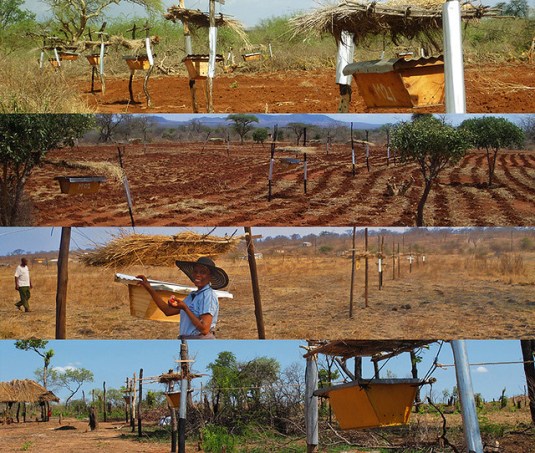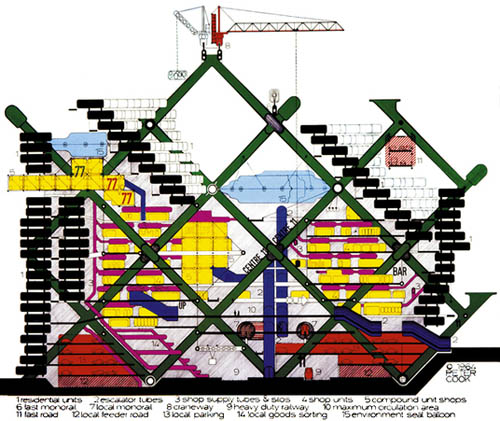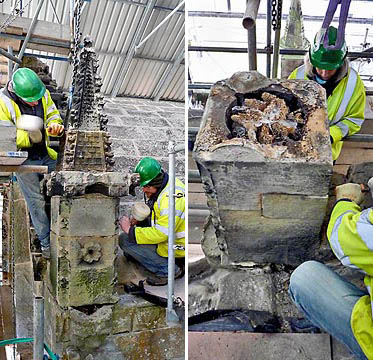 [Image: Photo courtesy of the USGS Bee Inventory and Monitoring Lab’s amazing Flickr set, via Science Friday].
[Image: Photo courtesy of the USGS Bee Inventory and Monitoring Lab’s amazing Flickr set, via Science Friday].
In a poem I clipped from The New Yorker a while back, Davis McCombs describes what he memorably calls “Dumpster Honey.” It remains a great illustration of altered natures—and the fate of food—in the Anthropocene.
McCombs shows us bees wandering through a rubbish heap “of candy wrappers and the sticky rims / of dented cans, entering, as they might / a blossom, the ketchup-smeared burger // boxes,” mistaking a stained world of “food-grade waxes / mingling with Band-Aids” for healthy flora.
Hapless bees slip their little bodies past “solvents / and fresheners,” picking up industrial food dyes and “the high-fructose / corn nectars” of artificially processed edible waste.
With this in mind, recall several recent examples of bees feasting on edible chemicals in urban hinterlands, in one case actually turning their honey bright red.
As Susan Dominus wrote for The New York Times back in 2010, a stunned Brooklyn beekeeper “sent samples of the red substance that the bees were producing to an apiculturalist who works for New York State, and that expert, acting as a kind of forensic foodie, found the samples riddled with Red Dye No. 40, the same dye used in the maraschino cherry juice” being mixed at a nearby factory.
This had the dismaying effect, Dominus writes, that “an entire season that should have been devoted to honey yielded instead a red concoction that tasted metallic and then overly sweet.” (Amusingly, Brooklyn’s cherry-red honey also inadvertently revealed an illegal marijuana-growing operation.)
 [Image: Photo by Vincent Kessler, courtesy of Reuters, via National Geographic].
[Image: Photo by Vincent Kessler, courtesy of Reuters, via National Geographic].
Or, indeed, recall a group of French bees that fed on candy and thus produced vibrant honeys in unearthly shades of green and blue. This honey of the Anthropocene “could not be sold because it did not meet France’s standards of honey production,” perhaps a technicolor warning sign, as the very possibility of a nature independent of humanity comes into question.
In the post-natural microcosm of “Dumpster Honey,” meanwhile, McCombs depicts his polluted bees “returning, smudged with the dust / of industrial pollens, to, perhaps, some // rusted tailpipe hive where their queen / grew fat on the the froth of artificial sweeteners,” a vision at once apocalyptic and, I suppose, if one really wishes it to be, ruthlessly optimistic.
After all, perhaps, amidst the litter and ruin of a formerly teeming world, some new nature might yet spring forth, thriving on the sugared colors of factory sludge, beautifully adapting to a world remade in humanity’s chemical image.
It’s worth reading the poem in full. It stands on its own as a vivid encapsulation of these sorts of overlooked, peripheral transformations of the world as we forcibly transition an entire planet into a new geo- and biological era.
(Somewhat related: Architecture-by-Bee and Other Animal Printheads.)
 [Images: From
[Images: From  [Images: Via
[Images: Via  [Image: “
[Image: “ [Image:
[Image:  [Images: The Rosslyn Chapel hives; photos courtesy of the
[Images: The Rosslyn Chapel hives; photos courtesy of the